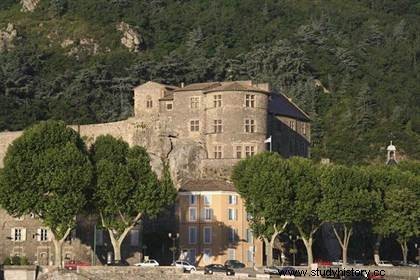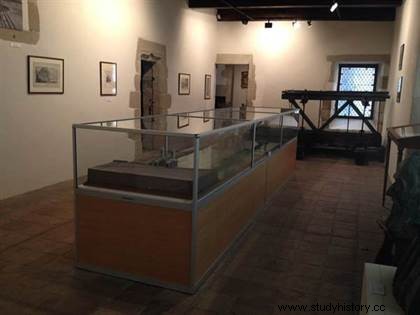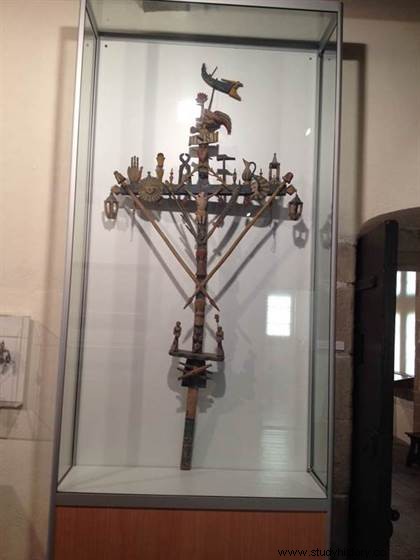 On the road to vacation, or stuck on National 7? Enjoy a moment of relaxation at the Château de Tournon . Perched on a rock, the Château de Tournon, whose origins date back to the 9th century, is one of the most beautiful castles in northern Ardèche. The buildings remaining today, and which you can admire, date from the 14th-15th centuries and were the dwelling place of the Counts of Tournon. Today a museum of France, the castle-museum is composed of a first level dedicated to the history of the castle and the Tournon family, a second level hosting a Rhône museum and a part devoted to exhibitions temporary.
On the road to vacation, or stuck on National 7? Enjoy a moment of relaxation at the Château de Tournon . Perched on a rock, the Château de Tournon, whose origins date back to the 9th century, is one of the most beautiful castles in northern Ardèche. The buildings remaining today, and which you can admire, date from the 14th-15th centuries and were the dwelling place of the Counts of Tournon. Today a museum of France, the castle-museum is composed of a first level dedicated to the history of the castle and the Tournon family, a second level hosting a Rhône museum and a part devoted to exhibitions temporary.
The history of the Château de Tournon
The Château de Tournon overlooks the Rhone Valley. Originally the river arrived at the foot of the castle, which allowed the Tournon family to install a toll there, the profits of which went into the enrichment and expansion of the castle. The city has known the passage of Saint Louis, François 1er or even Catherine de Médicis, but was also the place where the eldest son of François 1er died.
The Tournon family was an extremely important family, some of whose members held prominent positions at the French court.
 Cardinal François de Tournon was an outstanding personality. He was indeed a statesman and a man of the Church, appointed cardinal at the age of 40 (1530), but also the minister of François 1er. He indeed negotiated the release of the king after the defeat of Pavia in 1525. This humanist was also ambassador to Rome, in the midst of the Italian Renaissance, which enabled him to meet artists of his time, but also to buy certain paintings. to enrich the collections or even to bring back Italian artists like Giovanni Capassini who is the author of a large triptych, with the theme of the Resurrection and having been made in 1555. It is presented in the private chapel of the counts. But the cardinal also had a notable importance for the city since he founded there in 1536 the first provincial college, still used today and being known as the Gabriel Faure high school.
Cardinal François de Tournon was an outstanding personality. He was indeed a statesman and a man of the Church, appointed cardinal at the age of 40 (1530), but also the minister of François 1er. He indeed negotiated the release of the king after the defeat of Pavia in 1525. This humanist was also ambassador to Rome, in the midst of the Italian Renaissance, which enabled him to meet artists of his time, but also to buy certain paintings. to enrich the collections or even to bring back Italian artists like Giovanni Capassini who is the author of a large triptych, with the theme of the Resurrection and having been made in 1555. It is presented in the private chapel of the counts. But the cardinal also had a notable importance for the city since he founded there in 1536 the first provincial college, still used today and being known as the Gabriel Faure high school.
Claude de la Tour Turenne was also one of the countesses who was very important to the expansion and embellishment of the castle. Dame-in-waiting to Queen Margot, she was the wife of Just II de Tournon and the founder of the city hospital, a rampart intended to protect the castle against Protestant attacks and the development of the south terrace.
Another member of the family who made an impression is Hélène de Tournon (1559-1577), the daughter of Claude de la Tour Turenne whose tragic death, following 'a heartache, inspired playwrights like Shakespeare for his play Hamlet, but also contemporary artists.
Abandonment and restoration of the castle
 In 1644, the last member of the Tournon family, Just Louis II de Tournon, died during a battle. Without descendants, the castle therefore belongs to one of the ancestors of the count, Marguerite de Montmorency who, aged 80, will never come to the castle. Gradually abandoned, stripped of its property and its collections, the castle quickly served as a prison (from 1670) which was widely used during the French Revolution. The traces of the prisoners are still visible today in the Beauregard tower by graffiti that were left there on the walls and by the bleeding present in the recesses of the windows. I
In 1644, the last member of the Tournon family, Just Louis II de Tournon, died during a battle. Without descendants, the castle therefore belongs to one of the ancestors of the count, Marguerite de Montmorency who, aged 80, will never come to the castle. Gradually abandoned, stripped of its property and its collections, the castle quickly served as a prison (from 1670) which was widely used during the French Revolution. The traces of the prisoners are still visible today in the Beauregard tower by graffiti that were left there on the walls and by the bleeding present in the recesses of the windows. I
burned in 1794, the castle became property of the municipality in 1809 and a civil court was installed in 1881 in the main building of the 14th century, thus removing all traces of the period medieval when looking at this building from the main courtyard. In 1926, the prison closed and the following year the facades and roofs were classified as historical monuments. The inauguration of the Rhône Museum in 1928 invites the public to get to know the place. The restoration of the castle, thanks in particular to the Tournonais writer Gabriel Faure, allowed the classification of the interior parts and the 16th century entrance door in 1938 and 1960. At the end of the 20th century, restoration work on the stairs, roofs and the development of a reception room are also being built. The court closed in 2009 and is now an exhibition hall.
The Rhone Museum
First installed in the castle chapel, the Rhône Museum was inaugurated in 1928 and is now installed on the second floor of the building. Five rooms present collections on bridges, boats or even local artists who have marked the city and the Ardèche.
The Marc Seguin Bridge
 Presented in one of the rooms of the museum, this bridge is the first suspension bridge over the Rhône. Built between 1823 and 1825 by Marc Seguin and his brothers, engineers from Annonay, it was built from the family's personal funds. Indeed, the companies usually financing the bridges were afraid that this building would not resist the current of the Rhone, having already brought down more than one bridge before the work of the CNR. Nevertheless, and against all expectations, this bridge will hold. It is indeed the result of several technical innovations. On the one hand, the concrete of the central pylon is a concrete which comes from Teil (70 km south of Tournon) and which has hydraulic properties allowing it to dry and harden under water. On the other hand, it is a truly innovative system of cables that makes the bridge extremely resistant and adapts to the fluctuations of the Rhône.
Presented in one of the rooms of the museum, this bridge is the first suspension bridge over the Rhône. Built between 1823 and 1825 by Marc Seguin and his brothers, engineers from Annonay, it was built from the family's personal funds. Indeed, the companies usually financing the bridges were afraid that this building would not resist the current of the Rhone, having already brought down more than one bridge before the work of the CNR. Nevertheless, and against all expectations, this bridge will hold. It is indeed the result of several technical innovations. On the one hand, the concrete of the central pylon is a concrete which comes from Teil (70 km south of Tournon) and which has hydraulic properties allowing it to dry and harden under water. On the other hand, it is a truly innovative system of cables that makes the bridge extremely resistant and adapts to the fluctuations of the Rhône.
Today however, if you walk along the quays of Tournon you will no longer see the Marc Seguin bridge. Too low to allow boats to pass, it was indeed destroyed in 1965. This destruction was a real trauma for the people of Tournon who carried out funeral processions throughout the town and threw wreaths of flowers into the Rhône and affixed a plaque to the location of the bridge, which is still visible today at the foot of the castle.
Shipping
 Exhibited in a second room, the collections trace the evolution of navigation on the Rhône, from sailors to boats steamed. This is an increasingly rare and local heritage, one of the exceptional elements of which is the presence of four sailors' crosses.
Exhibited in a second room, the collections trace the evolution of navigation on the Rhône, from sailors to boats steamed. This is an increasingly rare and local heritage, one of the exceptional elements of which is the presence of four sailors' crosses.
The sailors practiced towing in the 16th century, but were the victims of the vagaries of the Rhône, often having accidents which contributed to their particular devotion. They will indeed erect on their boats large crosses (from 50 cm to 1.50 m high) richly sculpted and decorated with arma christi, the elements of the passion of Christ. A personal touch is however brought by the sailors, it is the representation of their boat at the top, with the name of the corporation.
Surprising things can also be found in this room, in particular the model of a grappling boat from 1840. The Rhone shipping industry has in fact adapted and invented new types of boats called "eels" because of their narrowness and excessive length. The problem with these eel boats, however, is that they are not very manoeuvrable, so another type of boat called "grabs" is invented, which floats and rolls, thanks to a wheel which clings to the bottom of the river and helps the boat to withstand strong currents.
Local artists
Three rooms are then dedicated to local artists. A gallery of paintings from the 19th century to the present day on the theme of the Rhône and among which are paintings by Max Monier de la Sizeranne, a room devoted to Marcel Gimond (1894-1961) who was a pupil of Maillol and Renoir and who is known for the "busts" or "portraits" of his contemporaries. Finally, a room devoted to the Ardèche intellectual heritage and more particularly to the publisher and poet Charles Forot and the friends of the dovecote, whose works, richly decorated by Jean Chièze, are very valuable today.
Practical information
Castle museum of Tournon
14 place Auguste Faure
07300 Tournon sur Rhône
Shaded parking at the foot of the site
